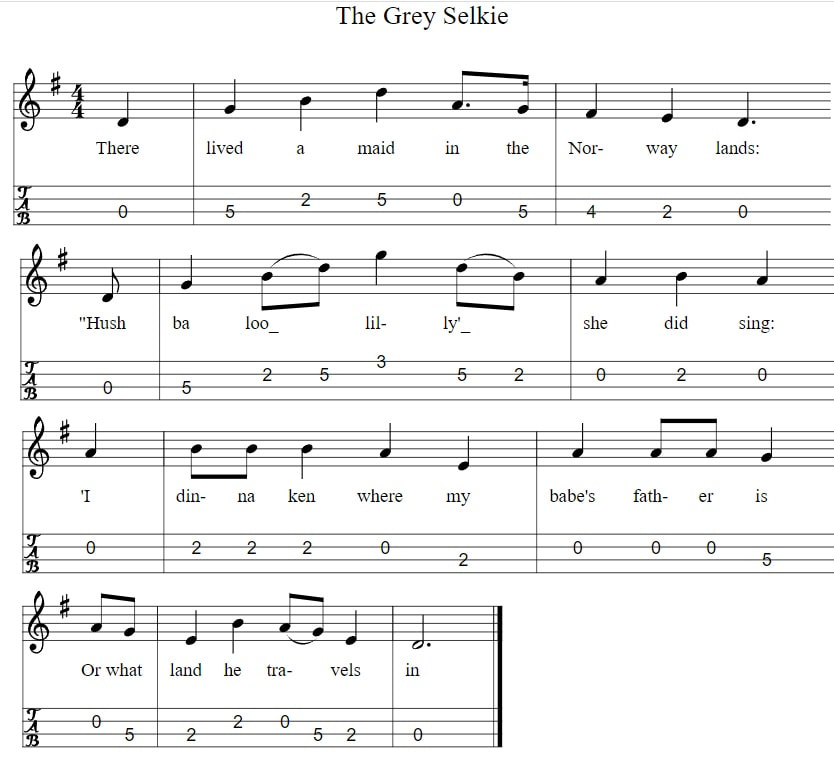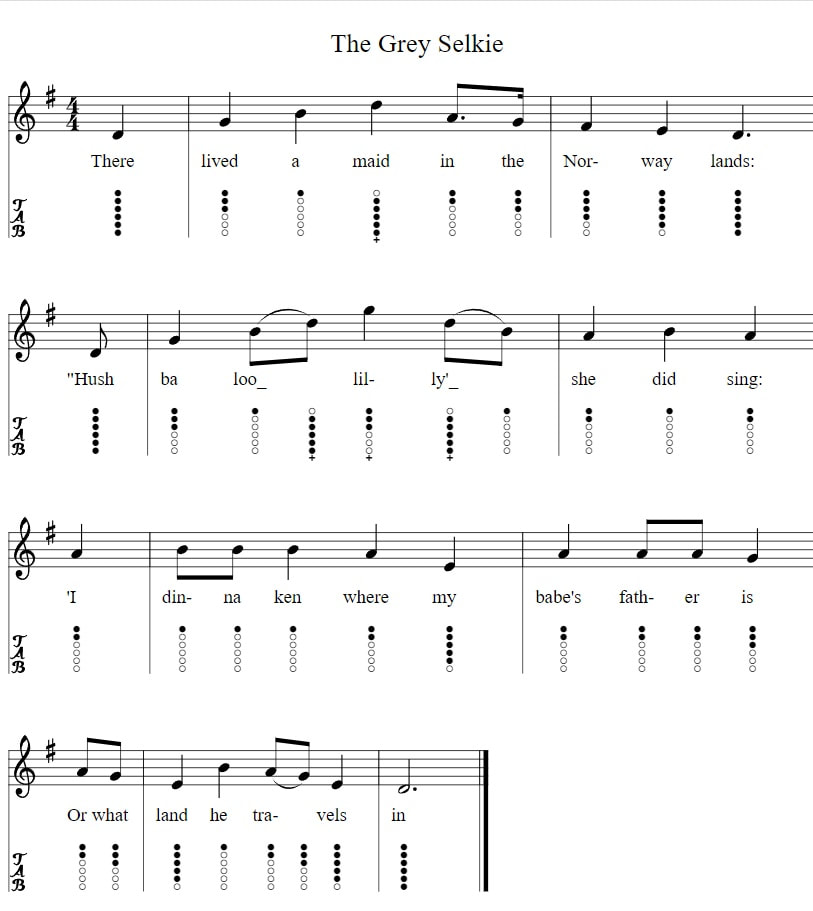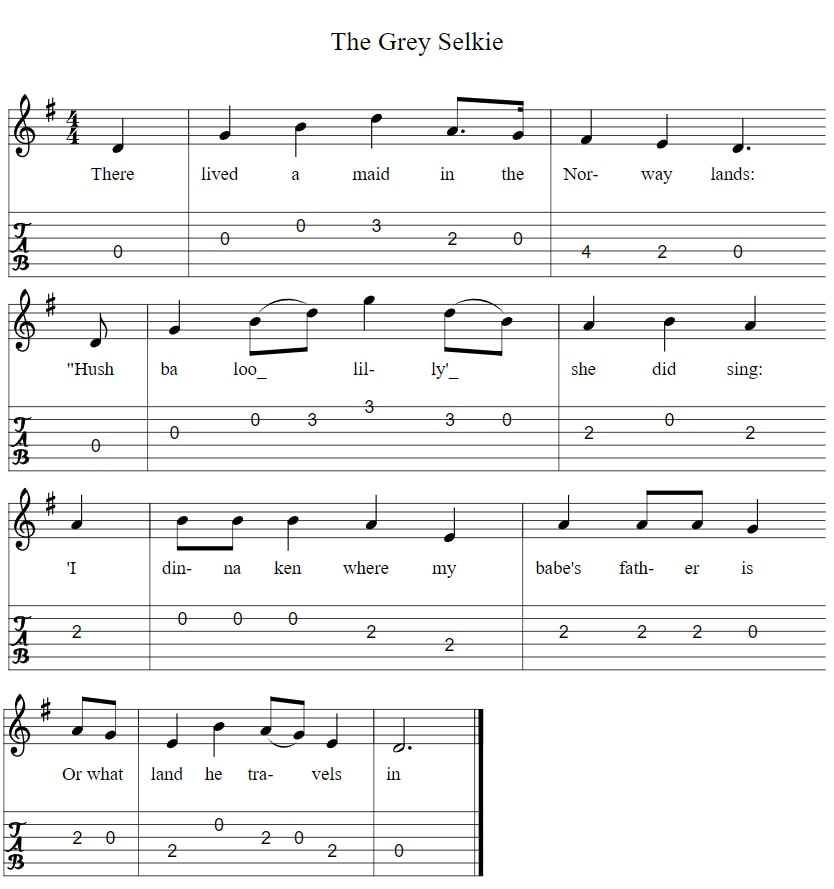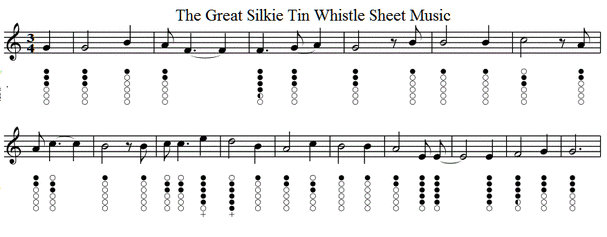The Great Silkie lyrics and Chords By The Corries
A traditional Scottish song. This ballad comes from the North Of Scotland, a ballad concerning ''A Seal Man'' who's one of the legentary characters who is part seal and part man. When he's at sea he's a seal and when he's on land he's a man. The unfortunate thing about this character is that he can only mate when he's a man, so he has to come on land every so often to find a maiden where he seduces her and leaves her bearing his off-spring. He heads back to sea for a few years before returning as a man to reclaim his son. More of the Scottish folk songs by The Corries . The sheet music and tin whistle notes are included.
The Great Silkie song is a traditional Scottish ballad that has captivated audiences for centuries with its haunting melody and enigmatic lyrics. The song tells the story of a mythical creature, the Silkie, who is said to be a human-seal hybrid, and his relationship with a human woman. While the origins of the song are shrouded in mystery, it has endured through countless variations and has been passed down through generations, making it a significant part of Scottish folklore and culture.
The earliest known version of The Great Silkie song dates back to the 19th century, but it is believed to have originated much earlier, possibly as far back as the Middle Ages. The song has been recorded by various artists and has been adapted into different forms, including poems, novels, and plays. This widespread popularity of the song is a testament to its enduring appeal and the timeless themes it explores.
The song opens with a woman lamenting the loss of her beloved child, who she believes has been taken away by a Silkie. She describes the Silkie as a creature with skin as soft as silk and eyes as blue as the sea. The woman's sorrow and longing for her child are palpable in the lyrics, setting the tone for the rest of the song.
As the song progresses, we learn that the Silkie has come ashore to seduce the woman, and she gives in to his advances. The Silkie promises to return to her every seven years, but the woman knows that she will never see him again. This bittersweet love story between a mortal and a mythical creature is the heart of the song and has been interpreted in various ways.
One interpretation of the song suggests that the Silkie represents a sailor who is forced to leave his family and go to sea, leaving his lover behind. The seven-year cycle could refer to the length of time sailors were typically away on voyages. Another interpretation sees the Silkie as a metaphor for the dangers and temptations of the sea, and the woman's longing for him as a representation of the lure of the unknown.
The Great Silkie song also explores themes of love, loss, and longing. The woman's love for the Silkie is all-consuming, and even though she knows he will never return, she cannot help but yearn for him. This unfulfilled desire is a recurring theme in Scottish folklore and literature, where it is often associated with the rugged landscape and the harsh realities of life.
The song also delves into the duality of nature, with the Silkie embodying both the wild and the human world. His ability to transform from a seal to a man and back again is a reflection of the ancient Celtic belief in shape-shifting and the interconnectedness of all living things. This theme of duality is further emphasized by the contrast between the woman's domestic life and the Silkie's untamed existence in the sea.
The Great Silkie song has also been seen as a commentary on the treatment of women in Scottish society. The woman in the song is portrayed as a victim of the Silkie's seduction, and her fate is ultimately decided by the actions of a male creature. This echoes the patriarchal nature of Scottish society at the time the song was written, where women had limited agency and were often at the mercy of men.
In conclusion, The Great Silkie song is a timeless masterpiece that has endured for centuries, captivating audiences with its haunting melody and poignant lyrics. Its themes of love, loss, and duality, along with its exploration of Scottish folklore and societal norms, make it a significant part of Scottish culture. The song's enduring popularity is a testament to its lasting impact and its ability to resonate with audiences across generations.
The earliest known version of The Great Silkie song dates back to the 19th century, but it is believed to have originated much earlier, possibly as far back as the Middle Ages. The song has been recorded by various artists and has been adapted into different forms, including poems, novels, and plays. This widespread popularity of the song is a testament to its enduring appeal and the timeless themes it explores.
The song opens with a woman lamenting the loss of her beloved child, who she believes has been taken away by a Silkie. She describes the Silkie as a creature with skin as soft as silk and eyes as blue as the sea. The woman's sorrow and longing for her child are palpable in the lyrics, setting the tone for the rest of the song.
As the song progresses, we learn that the Silkie has come ashore to seduce the woman, and she gives in to his advances. The Silkie promises to return to her every seven years, but the woman knows that she will never see him again. This bittersweet love story between a mortal and a mythical creature is the heart of the song and has been interpreted in various ways.
One interpretation of the song suggests that the Silkie represents a sailor who is forced to leave his family and go to sea, leaving his lover behind. The seven-year cycle could refer to the length of time sailors were typically away on voyages. Another interpretation sees the Silkie as a metaphor for the dangers and temptations of the sea, and the woman's longing for him as a representation of the lure of the unknown.
The Great Silkie song also explores themes of love, loss, and longing. The woman's love for the Silkie is all-consuming, and even though she knows he will never return, she cannot help but yearn for him. This unfulfilled desire is a recurring theme in Scottish folklore and literature, where it is often associated with the rugged landscape and the harsh realities of life.
The song also delves into the duality of nature, with the Silkie embodying both the wild and the human world. His ability to transform from a seal to a man and back again is a reflection of the ancient Celtic belief in shape-shifting and the interconnectedness of all living things. This theme of duality is further emphasized by the contrast between the woman's domestic life and the Silkie's untamed existence in the sea.
The Great Silkie song has also been seen as a commentary on the treatment of women in Scottish society. The woman in the song is portrayed as a victim of the Silkie's seduction, and her fate is ultimately decided by the actions of a male creature. This echoes the patriarchal nature of Scottish society at the time the song was written, where women had limited agency and were often at the mercy of men.
In conclusion, The Great Silkie song is a timeless masterpiece that has endured for centuries, captivating audiences with its haunting melody and poignant lyrics. Its themes of love, loss, and duality, along with its exploration of Scottish folklore and societal norms, make it a significant part of Scottish culture. The song's enduring popularity is a testament to its lasting impact and its ability to resonate with audiences across generations.







